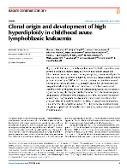Clonal origin and development of high hyperdiploidy in childhood acute lymphoblastic leukaemia

Autor
Woodward, Eleanor L
Yang, Minjun
Moura-Castro, Larissa H
van den Bos, Hilda
Gunnarsson, Rebeqa
Olsson-Arvidsson, Linda
Spierings, Diana C J
Castor, Anders
Duployez, Nicolas
Johansson, Bertil
Foijer, Floris
Paulsson, Kajsa
Datum vydání
2023Publikováno v
Nature CommunicationsRočník / Číslo vydání
14 (1)ISBN / ISSN
ISSN: 2041-1723ISBN / ISSN
eISSN: 2041-1723Metadata
Zobrazit celý záznamKolekce
Tato publikace má vydavatelskou verzi s DOI 10.1038/s41467-023-37356-5
Abstrakt
High hyperdiploid acute lymphoblastic leukemia (HeH ALL), one of the most common childhood malignancies, is driven by nonrandom aneuploidy (abnormal chromosome numbers) mainly comprising chromosomal gains. In this study, we investigate how aneuploidy in HeH ALL arises. Single cell whole genome sequencing of 2847 cells from nine primary cases and one normal bone marrow reveals that HeH ALL generally display low chromosomal heterogeneity, indicating that they are not characterized by chromosomal instability and showing that aneuploidy-driven malignancies are not necessarily chromosomally heterogeneous. Furthermore, most chromosomal gains are present in all leukemic cells, suggesting that they arose early during leukemogenesis. Copy number data from 577 primary cases reveals selective pressures that were used for in silico modeling of aneuploidy development. This shows that the aneuploidy in HeH ALL likely arises by an initial tripolar mitosis in a diploid cell followed by clonal evolution, in line with a punctuated evolution model.
Klíčová slova
High hyperdiploid acute lymphoblastic leukemia, HeH ALL
Trvalý odkaz
https://hdl.handle.net/20.500.14178/2045Licence
Licence pro užití plného textu výsledku: Creative Commons Uveďte původ 4.0 International






